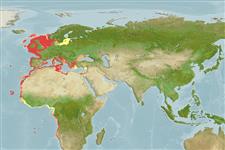Teleostei (teleosts) >
Eupercaria/misc (Various families in series Eupercaria) >
Sparidae (Porgies)
Etymology: Spondyliosoma: Greek, spondylos = vertebra (1667) + Greek, soma = body (Ref. 45335).
More on author: Linnaeus.
Environment: milieu / climate zone / depth range / distribution range
Ecology
Marine; benthopelagic; oceanodromous (Ref. 51243); depth range 5 - 300 m (Ref. 3688). Subtropical; 63°N - 20°S, 26°W - 36°E
Eastern Atlantic: Scandinavia to northern Namibia (Ref. 11228), including the Strait of Gibraltar, Mediterranean and the Black Sea, Madeira, Canary Islands, and Cape Verde.
Length at first maturity / Size / Weight / Age
Maturity: Lm 19.7 range ? - ? cm
Max length : 60.0 cm SL male/unsexed; (Ref. 4781); common length : 30.0 cm SL male/unsexed; (Ref. 4781); max. published weight: 1.2 kg (Ref. 40637)
Dorsal spines (total): 11; Dorsal soft rays (total): 11 - 13. Body tall, with weak longitudinal stripes and no dark spots. Snout as long or longer than the eye diameter (Ref. 35388).
Found over seagrass beds and rocky and sandy bottoms to about 300 m (Ref. 3688). Gregarious, sometimes in large schools (Ref. 3688). Omnivorous, feeding on seaweeds and small invertebrates, especially crustaceans (Ref. 3688). Protogynic hermaphrodites (Ref. 4781). An important food fish.
Lays eggs on sandy bottom (Ref. 4781). Sex reversal occurs at approximately 24.3 cm TL in population from Algeria (Ref. 102321). Also Ref. 28504.
Bauchot, M.-L. and J.-C. Hureau, 1990. Sparidae. p. 790-812. In J.C. Quero, J.C. Hureau, C. Karrer, A. Post and L. Saldanha (eds.) Check-list of the fishes of the eastern tropical Atlantic (CLOFETA). JNICT, Lisbon; SEI, Paris; and UNESCO, Paris. Vol. 2. (Ref. 3688)
IUCN Red List Status (Ref. 130435)
Threat to humans
Harmless
Human uses
Fisheries: commercial; gamefish: yes; aquarium: public aquariums
Tools
Special reports
Download XML
Internet sources
Estimates based on models
Preferred temperature (Ref.
123201): 7 - 17.2, mean 10.2 °C (based on 645 cells).
Phylogenetic diversity index (Ref.
82804): PD
50 = 0.7500 [Uniqueness, from 0.5 = low to 2.0 = high].
Bayesian length-weight: a=0.01230 (0.01114 - 0.01358), b=3.03 (3.00 - 3.06), in cm total length, based on LWR estimates for this species (Ref.
93245).
Trophic level (Ref.
69278): 3.3 ±0.2 se; based on diet studies.
Resilience (Ref.
120179): Medium, minimum population doubling time 1.4 - 4.4 years (K=0.3; Fec=36,000; tm=4).
Prior r = 0.47, 95% CL = 0.31 - 0.71, Based on 3 data-limited stock assessments.
Fishing Vulnerability (Ref.
59153): Moderate vulnerability (37 of 100).
Climate Vulnerability (Ref.
125649): Moderate vulnerability (41 of 100).
Nutrients (Ref.
124155): Calcium = 51.6 [28.4, 94.8] mg/100g; Iron = 0.873 [0.494, 1.476] mg/100g; Protein = 19 [17, 21] %; Omega3 = 0.394 [0.268, 0.583] g/100g; Selenium = 39.4 [20.0, 72.3] μg/100g; VitaminA = 12.9 [3.9, 37.7] μg/100g; Zinc = 0.742 [0.530, 1.043] mg/100g (wet weight); based on
nutrient studies.
